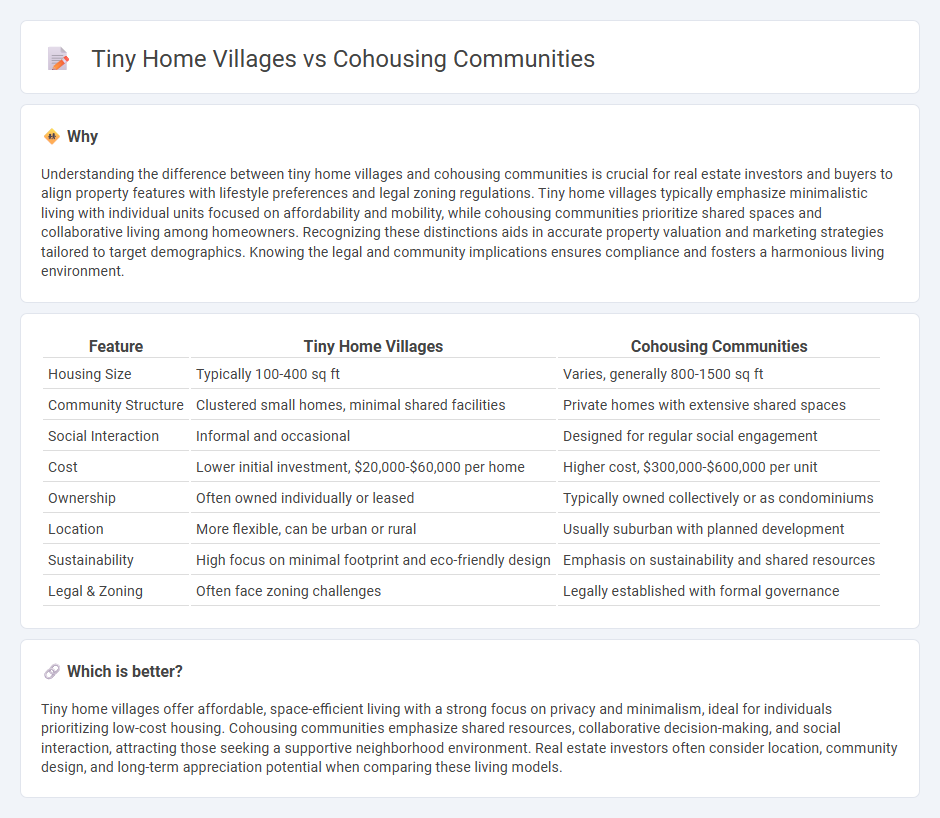
Tiny home villages offer compact, affordable living spaces designed to maximize efficiency and foster close-knit communities through shared amenities. Cohousing communities emphasize collaborative design, where residents actively participate in planning and maintain private homes alongside common spaces for social interaction and sustainability. Explore the unique benefits and lifestyle opportunities of both tiny home villages and cohousing communities to find the ideal real estate solution.
Why it is important
Understanding the difference between tiny home villages and cohousing communities is crucial for real estate investors and buyers to align property features with lifestyle preferences and legal zoning regulations. Tiny home villages typically emphasize minimalistic living with individual units focused on affordability and mobility, while cohousing communities prioritize shared spaces and collaborative living among homeowners. Recognizing these distinctions aids in accurate property valuation and marketing strategies tailored to target demographics. Knowing the legal and community implications ensures compliance and fosters a harmonious living environment.
Comparison Table
| Feature | Tiny Home Villages | Cohousing Communities |
|---|---|---|
| Housing Size | Typically 100-400 sq ft | Varies, generally 800-1500 sq ft |
| Community Structure | Clustered small homes, minimal shared facilities | Private homes with extensive shared spaces |
| Social Interaction | Informal and occasional | Designed for regular social engagement |
| Cost | Lower initial investment, $20,000-$60,000 per home | Higher cost, $300,000-$600,000 per unit |
| Ownership | Often owned individually or leased | Typically owned collectively or as condominiums |
| Location | More flexible, can be urban or rural | Usually suburban with planned development |
| Sustainability | High focus on minimal footprint and eco-friendly design | Emphasis on sustainability and shared resources |
| Legal & Zoning | Often face zoning challenges | Legally established with formal governance |
Which is better?
Tiny home villages offer affordable, space-efficient living with a strong focus on privacy and minimalism, ideal for individuals prioritizing low-cost housing. Cohousing communities emphasize shared resources, collaborative decision-making, and social interaction, attracting those seeking a supportive neighborhood environment. Real estate investors often consider location, community design, and long-term appreciation potential when comparing these living models.
Connection
Tiny home villages and cohousing communities share a focus on sustainable living by promoting communal spaces and resource sharing to reduce environmental impact. Both models emphasize affordability, social interaction, and efficient land use, attracting residents seeking alternatives to traditional single-family homes. Their interconnected design fosters strong support networks and enhances community resilience through collaborative decision-making and shared amenities.
Key Terms
**Cohousing Communities:**
Cohousing communities are intentionally designed neighborhoods where residents actively participate in the planning and management of shared spaces, fostering strong social connections and cooperative living. They typically feature private homes clustered around common areas such as kitchens, gardens, and recreational facilities, supporting sustainable and community-oriented lifestyles. Explore the benefits and unique aspects of cohousing communities to learn how they create balanced environments blending privacy with collaboration.
Shared Common Spaces
Cohousing communities emphasize extensive shared common spaces, including kitchens, dining areas, and recreational facilities that foster social interaction and collective living. Tiny home villages feature smaller-scale communal areas, often designed to maximize privacy while providing essential shared amenities like gardens or meeting rooms. Explore deeper insights into how these communal designs impact resident experiences and lifestyle choices.
Collaborative Decision-Making
Cohousing communities emphasize collaborative decision-making through structured consensus or sociocratic processes, fostering strong member engagement and shared responsibility. Tiny home villages often implement simplified, flexible decision frameworks suited to smaller, transient populations, balancing community needs with individual autonomy. Explore how these distinctive governance models shape social cohesion and resident satisfaction in both housing types.
Source and External Links
Cohousing - Cohousing is an intentional community where residents live in private homes with shared spaces, fostering social interaction and cooperation.
The Benefits of Living in Senior Cohousing Communities - This article discusses how senior cohousing communities promote social interaction and reduce isolation through shared spaces and activities.
Sunnyside Village Cohousing - Sunnyside Village is an intentional community focused on collaboration, sustainability, and healthy living, featuring private homes and shared community spaces.
 dowidth.com
dowidth.com